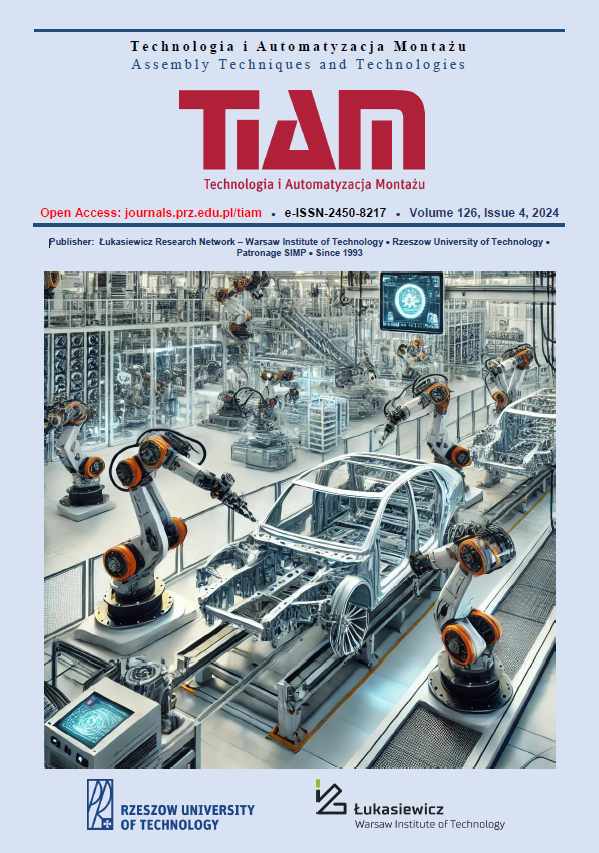Abstract
Assembly technology plays a crucial role in the manufacturing process, influencing the efficiency, quality, cost and lead time of production. Assembly technology in the manufacturing process encompasses all techniques and methods used to join components into a finished product. Depending on the industry and specific requirements, assembly technologies can include a variety of techniques, from traditional mechanical joints to advanced bonding, welding or soldering methods. The paper analysed the feasibility of implementing alternative methods of joining blanks in the steel wheel manufacturing process. Testing was carried out to replace the wheel rim flash welding process with laser welding. The effectiveness of laser welding was evaluated by testing prepared butt jointed sheet samples. Tests were carried out on two types of structural steel: S355MC and DD11, which were subjected to flash welding and laser welding. The specimens were subjected to strength and macrographic tests to analyse their structure and mechanical properties. The results showed that laser welding for DD11 steel leads to an increase in tensile strength, while for S355MC steel this strength is reduced. Statistical analysis showed no significant differences between the assembly methods used and the steel types. Macrographic tests confirmed the presence of oxides and other characteristics of the assembly methods used. The results suggest that the choice of the appropriate joining method can have a significant impact on the quality and durability of the final product, which is crucial in the context of steel wheel production
References
Al-Mukhtar, A. M. (2016). Review of Resistance Spot Welding Sheets: Processes and Failure Mode. Advanced Engineering Forum, 17, 31–57. doi: 10.4028/www.scientific.net/AEF.17.31
Balaraju, J. N., Sankara Narayanan, T. S. N., & Seshadri, S. K. (2003). Electroless Ni–P composite coatings. Journal of Applied Electrochemistry, 33(9), 807–816. doi: 10.1023/A:1025572410205
Biradar, A. K., & Dabade, B. M. (2020). Optimization of resistance spot welding process parameters in dissimilar joint of MS and ASS 304 sheets. Materials Today: Proceedings, 26, 1284–1288. doi: 10.1016/j.matpr.2020.02.256
Cohen, Y., Naseraldin, H., Chaudhuri, A., & Pilati, F. (2019). Assembly systems in Industry 4.0 era: A road map to understand Assembly 4.0. The International Journal of Advanced Manufacturing Technology, 105(9), 4037–4054. doi: 10.1007/s00170-019-04203-1
Fernandes, F. A. O., Oliveira, D. F., & Pereira, A. B. (2017). Optimal parameters for laser welding of advanced high-strength steels used in the automotive industry. Procedia Manufacturing, 13, 219–226. doi: 10.1016/j.promfg.2017.09.052
Fysikopoulos, A., Pastras, G., Stavridis, J., Stavropoulos, P., & Chryssolouris, G. (2016). On the Performance Evaluation of Remote Laser Welding Process: An Automotive Case Study. Procedia CIRP, 41, 969–974. doi: 10.1016/j.procir.2016.01.005
Hajializadeh, F., & Mashhadi, M. M. (2015). Investigation and numerical analysis of impulsive hydroforming of aluminum 6061-T6 tube. Journal of Manufacturing Processes, 20, 257–273. doi: 10.1016/j.jmapro.2015.06.027
Hong, K.-M., & Shin, Y. C. (2017). Prospects of laser welding technology in the automotive industry: A review. Journal of Materials Processing Technology, 245, 46–69. doi: 10.1016/j.jmatprotec.2017.02.008
Https://www.steelnumber.com/en/steel_composition_eu.php?name_id=206. (2024).
Https://www.steelnumber.com/en/steel_composition_eu.php?name_id=218. (2024).
K Srivastava, A., & Sharma, A. (2017). Advances in Joining and Welding Technologies for Automotive and Electronic Applications. American Journal of Materials Engineering and Technology, 5(1), 7–13. doi: 10.12691/materials-5-1-2
Kimchi, M., & Phillips, D. H. (2023). Resistance spot welding: Fundamentals and applications for the automotive industry (Second edition). Cham: Springer.
Manoharan, K. A., Bashir, M. N., & Zaifuddin, A. Q. (2020). An Overview of Laser Welding of High Strength Steels for Automotive Application. International Journal of Technology and Engineering Studies, 6(1), 23–40. doi: 10.20469/ijtes.6.10004-1
Mei, L., Yan, D., Chen, G., Xie, D., Zhang, M., & Ge, X. (2015). Comparative study on CO2 laser overlap welding and resistance spot welding for automotive body in white. Materials & Design, 78, 107–117. doi: 10.1016/j.matdes.2015.04.031
Mei, L., Yi, J., Yan, D., Liu, J., & Chen, G. (2012). Comparative study on CO2 laser overlap welding and resistance spot welding for galvanized steel. Materials & Design, 40, 433–442. doi: 10.1016/j.matdes.2012.04.014
Miturska, I, & Rudawska, A. (2021). Structural factors influence on strength properties of S235JR steel welded joints. Journal of Physics: Conference Series, 1736(1), 012004. doi: 10.1088/1742-6596/1736/1/012004
Miturska, Izabela, Rudawska, A., Pawlak, P., Stančeková, D., & Chyra, M. (2017). Comparative Analysis of Welded and Adhesive Joints Strength Made of Acid-Resistant Stainless Steel Sheets. Advances in Science and Technology Research Journal, 11(4), 97–102. doi: 10.12913/22998624/78165
Perka, A. K., John, M., Kuruveri, U. B., & Menezes, P. L. (2022). Advanced High-Strength Steels for Automotive Applications: Arc and Laser Welding Process, Properties, and Challenges. Metals, 12(6), 1051. doi: 10.3390/met12061051
PN-EN 10002-1:2004—Metallic materials—Tensile testing—Part 1: Method of test at ambient temperature. (2004).
Rossini, M., Spena, P. R., Cortese, L., Matteis, P., & Firrao, D. (2015). Investigation on dissimilar laser welding of advanced high strength steel sheets for the automotive industry. Materials Science and Engineering: A, 628, 288–296. doi: 10.1016/j.msea.2015.01.037
Szala, M., & Łukasik, D. (2018). Pitting Corrosion of the Resistance Welding Joints of Stainless Steel Ventilation Grille Operated in Swimming Pool Environment. International Journal of Corrosion, 2018, 1–7. doi: 10.1155/2018/9408670
Uchihara, M. (2011). Joining technologies for automotive steel sheets. Welding International, 25(4), 249–259. doi: 10.1080/09507111003655341
Xu, T., Shi, Y., Cui, Y., & Liang, Z. (2023). Effects of Magnetic Fields in Arc Welding, Laser Welding, and Resistance Spot Welding: A Review. Advanced Engineering Materials, 25(5), 2200682. doi: 10.1002/adem.202200682

